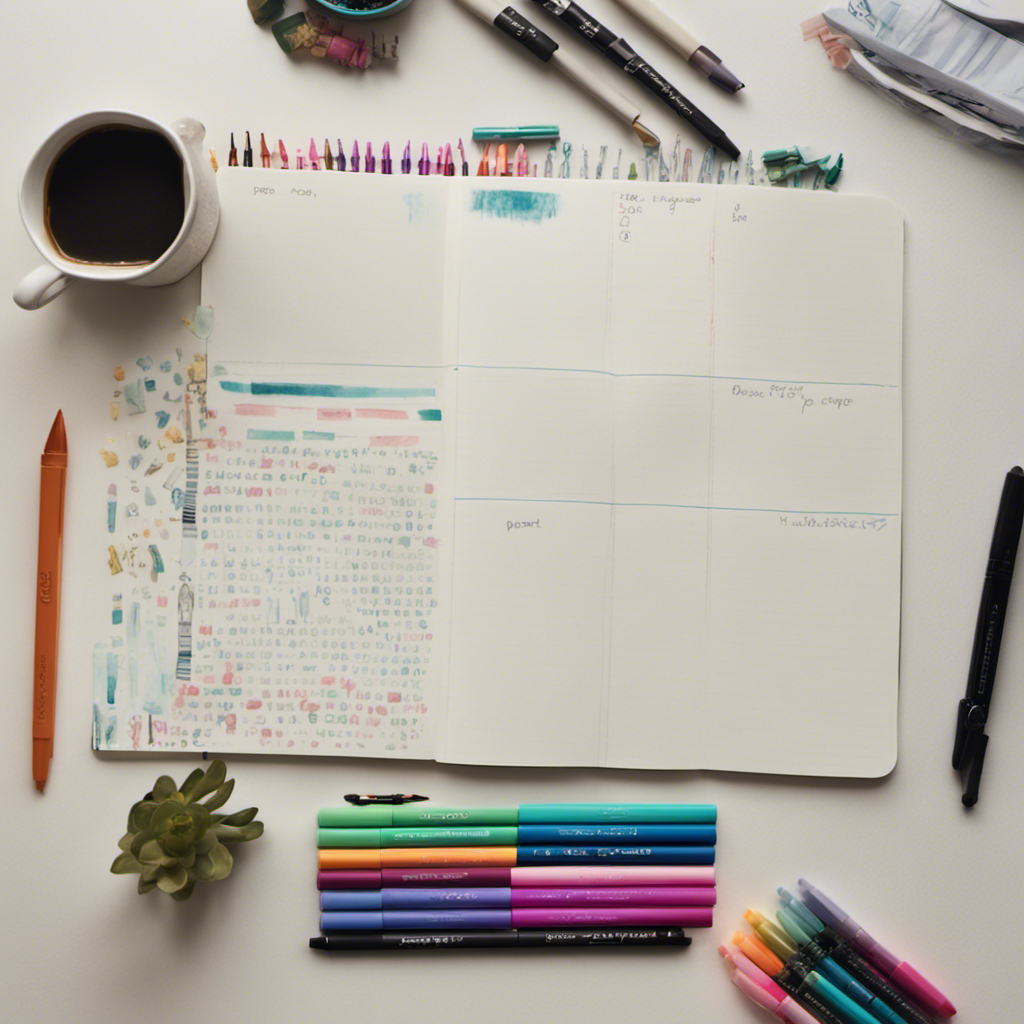
Bullet journaling offers a practical and creative solution for those seeking a sense of belonging in their daily routines. This step-by-step guide provides beginners with the tools and knowledge to embark on their journaling journey.
Discover how to choose the perfect journal and supplies, set up your bullet journal, track habits and goals, and add personal touches to make it uniquely yours.
Join the community of bullet journal enthusiasts and find your own place in this creative and organized world.
Choosing the Right Journal and Supplies
She recommends finding a journal that has thick, high-quality paper. This is essential because it allows for smoother writing and prevents ink from bleeding through the pages. A journal with thicker paper also gives a sense of durability, making it feel more special and long-lasting. Additionally, the high-quality paper provides a better canvas for creative expressions such as doodling or using different types of pens and markers.
It’s important to choose a journal that suits one’s personal style and preferences. Whether it’s a minimalist design or a colorful and vibrant cover, finding a journal that resonates with one’s aesthetic can enhance the overall experience of bullet journaling. Ultimately, the right journal creates a sense of belonging and ownership, making it a cherished tool for self-expression and organization.
Setting Up Your Bullet Journal
The first step in setting up your bullet journal is to gather all the necessary supplies.
To create a sense of belonging, it’s important to have the right tools at hand. Start by choosing a journal that speaks to you, whether it’s a simple notebook or a more elaborate one with customizable sections.
Next, gather pens, markers, and highlighters in various colors to make your journal visually appealing. Don’t forget to have a ruler or straight edge for creating neat lines and grids.
Additionally, consider including sticky notes, washi tape, and stickers for added creativity.
Once you have all your supplies, find a comfortable and quiet space where you can focus on setting up your journal without distractions.
Creating Monthly and Weekly Spreads
To create efficient and organized monthly and weekly spreads, gather your favorite pens and a ruler to begin.
Start by designing your monthly spread, which will give you an overview of the entire month. Use your ruler to draw a grid, dividing the page into sections for each day of the month. Add important dates, appointments, and events to each corresponding day.
Next, move on to the weekly spreads. These spreads will provide a more detailed view of each week. Use the same method of creating a grid, but this time, divide the page into sections for each day of the week. Include tasks, goals, and reminders for each day. Don’t forget to leave space for notes and reflections.
With these monthly and weekly spreads, you’ll have a clear and organized plan to guide you through your days and weeks.
Tracking Habits and Goals
For effectively tracking habits and goals in a bullet journal, one can use the method of creating habit trackers and goal lists. These tools can help individuals stay organized and motivated in their pursuit of personal growth and self-improvement.
Habit trackers allow users to visually track their daily habits, such as exercise, reading, or meditation, by marking off each day they successfully complete the task. This visual representation provides a sense of accomplishment and encourages consistency.
On the other hand, goal lists help individuals define their long-term objectives and break them down into manageable steps. By writing down their goals and regularly reviewing them, individuals can stay focused and motivated on their journey.
Both habit trackers and goal lists promote a sense of belonging by providing structure and guidance, helping individuals stay accountable to themselves and their aspirations.
Adding Creative Touches and Personalization
With a combination of washi tape and colored pens, individuals can add a personal touch to their bullet journal and make it truly unique. Adding creative touches and personalization allows individuals to express their personality and make their journal a reflection of themselves.
They can incorporate their favorite colors, patterns, and designs into the pages of their journal, creating a visually appealing and aesthetically pleasing layout. By including drawings, doodles, and hand-lettering, they can further personalize their journal and make it a true work of art.
This creative process not only adds a sense of belonging but also provides a therapeutic outlet for self-expression and creativity. It allows individuals to infuse their own style and individuality into their bullet journal, making it a true reflection of who they are.
Frequently Asked Questions
How Do I Deal With Mistakes in My Bullet Journal?
When dealing with mistakes in their bullet journal, beginners can simply embrace imperfections and view them as opportunities to learn and grow. They can use creative solutions like covering up mistakes or turning them into unique design elements.
Can I Use a Digital Journaling App Instead of a Physical Notebook?
Yes, they can use a digital journaling app instead of a physical notebook. It offers convenience, accessibility, and the ability to easily correct mistakes. However, some people prefer the tactile experience of a physical journal.
What Is the Recommended Amount of Time to Spend on Bullet Journaling Each Day?
The recommended amount of time to spend on bullet journaling each day varies depending on individual preferences and goals. Some may find a few minutes sufficient, while others may dedicate hours to it.
How Do I Stay Motivated to Keep up With My Bullet Journaling Routine?
To stay motivated with their bullet journaling routine, one can set realistic goals, celebrate small achievements, and create a sense of community by joining online bullet journaling groups or sharing their progress with friends.
Are There Any Specific Tips for Using Bullet Journaling to Improve Productivity?
Using bullet journaling can greatly improve productivity. Some tips include setting clear goals, prioritizing tasks, and using symbols and color coding to organize information. Consistency and regular review are key.
Conclusion
In conclusion, bullet journaling is a versatile and customizable system that can help individuals stay organized, track their habits and goals, and unleash their creativity.
With the right journal and supplies, a well-structured setup, and personalized touches, anyone can begin their bullet journaling journey.
Whether you’re a beginner or a seasoned planner, this step-by-step guide provides a solid foundation for getting started and exploring the endless possibilities of bullet journaling.
Start today and watch your productivity and creativity soar.










